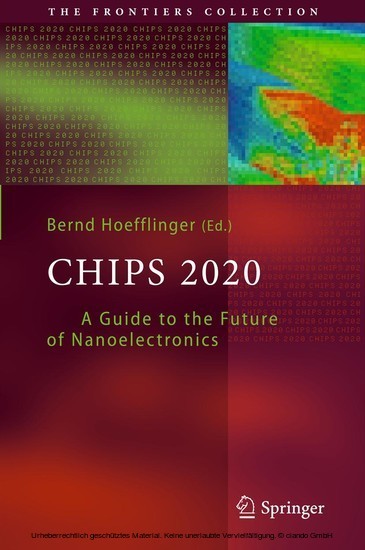Höfflinger, Bernd (Hrsg.)
Chips 2020
A Guide to the Future of Nanoelectronics

Beschreibung
Everyone s cell phone of 2010 has chips inside with Billions of sub-100-nanometer transistors. By 2020, we will see systems-on-chips with Trillions of 10-nanometer transistors.
However, this decade will see the end of the roadmap at 10 nanometers because smaller transistors, containing just a few control atoms, are no longer useful due to their fundamental statistical variance. There is also an immanent energy crisis, because, with 2010 chip technology, the internet of 2015 alone would consume the total global electrical power.
A new, sustainable roadmap is presented in this book towards femto(10-15)-Joule low-energy, high-performance electronics. The focus is on the energy-efficiency of all chip functionalities, sensing, processing, and communication, in a top-down spirit involving new architectures like silicon brains, ultra-low-voltage circuits, energy harvesting, and silicon technologies with three dimensions and a mix of compatible lithography and self-assembly.
A requirements-driven innovation ecosystem is the critical path to offer sustainable nanoelectronics to Billions of people. Recognized world leaders from the industry and from the research community share their views of this nanoelectronics future:
Ubiquitous communication based on mobile companions, health and care supported by autonomous implants and by personal carebots, safe and efficient mobility assisted by co-pilots equipped with intelligent micro-electromechanical systems (MEMS), and internet-based education for a Billion K-90 students.
The book should be helpful to all those who have to make decisions associated with future electronics, from students to graduates, to educators, to researchers, as well as to managers,
Investors, and policy makers.
However, this decade will see the end of the roadmap at 10 nanometers because smaller transistors, containing just a few control atoms, are no longer useful due to their fundamental statistical variance. There is also an immanent energy crisis, because, with 2010 chip technology, the internet of 2015 alone would consume the total global electrical power.
A new, sustainable roadmap is presented in this book towards femto(10-15)-Joule low-energy, high-performance electronics. The focus is on the energy-efficiency of all chip functionalities, sensing, processing, and communication, in a top-down spirit involving new architectures like silicon brains, ultra-low-voltage circuits, energy harvesting, and silicon technologies with three dimensions and a mix of compatible lithography and self-assembly.
A requirements-driven innovation ecosystem is the critical path to offer sustainable nanoelectronics to Billions of people. Recognized world leaders from the industry and from the research community share their views of this nanoelectronics future:
Ubiquitous communication based on mobile companions, health and care supported by autonomous implants and by personal carebots, safe and efficient mobility assisted by co-pilots equipped with intelligent micro-electromechanical systems (MEMS), and internet-based education for a Billion K-90 students.
The book should be helpful to all those who have to make decisions associated with future electronics, from students to graduates, to educators, to researchers, as well as to managers,
Investors, and policy makers.
Produktdetails
| ISBN/GTIN | 978-3-642-23096-7 |
|---|---|
| Seitenzahl | 477 S. |
| Kopierschutz | mit Wasserzeichen |
| Dateigröße | 20107 Kbytes |

